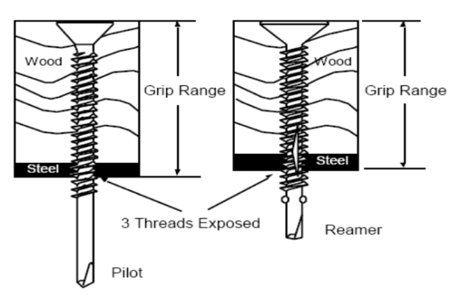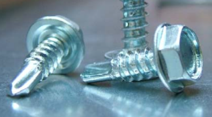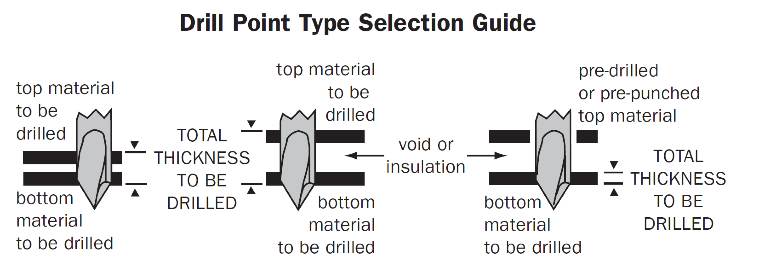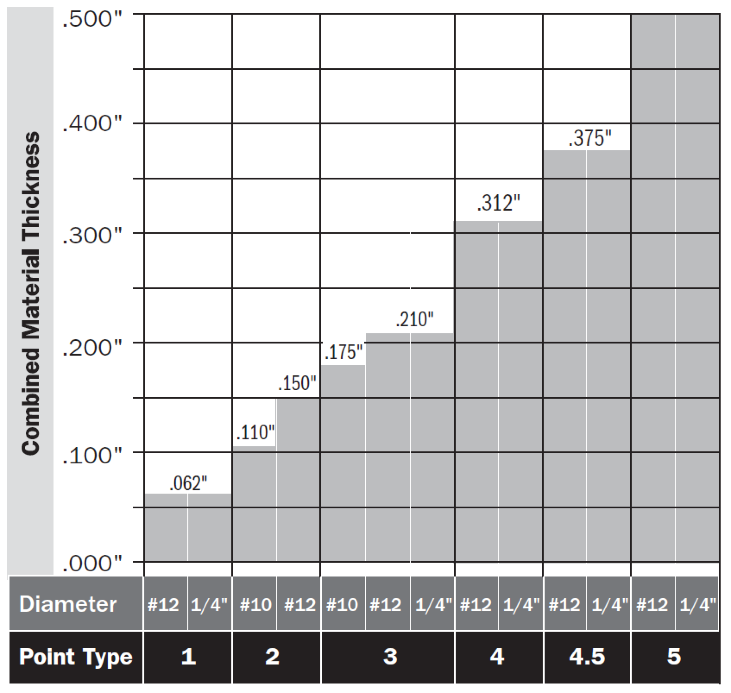Does it matter what type of fasteners you use with cold-formed steel (CFS) framing? If you think the answer is “no,” power down your screw gun right now.
According to the Cold-Formed Steel Engineers Institute’s (CFSEI) Technical Note On Cold-Formed Steel Construction — Screw Fastener Selection for Cold-Formed Steel Frame Construction (F102-11), “Specifying the proper fastener is necessary to assure the proper performance of the connections used in cold-formed steel construction.”
To help you make an informed decision about what fasteners are best for your CFS construction project, ask yourself the following three questions.
1. What type of construction is being considered?
 “You could say the type of fastener you should use depends on the type of wall, roof, or floor being constructed,” said Don Allen, P.E, LEED A.P., an internationally known expert on CFS. According to Allen, bolts are rarely used with CFS assemblies — usually only with “certain truss configurations and anchor bolts attaching sill plates, hold-downs, or joists to foundations.” And while welding has its place as a CFS connection, welded connections tend to appear in controlled conditions, such as in panelized construction.
“You could say the type of fastener you should use depends on the type of wall, roof, or floor being constructed,” said Don Allen, P.E, LEED A.P., an internationally known expert on CFS. According to Allen, bolts are rarely used with CFS assemblies — usually only with “certain truss configurations and anchor bolts attaching sill plates, hold-downs, or joists to foundations.” And while welding has its place as a CFS connection, welded connections tend to appear in controlled conditions, such as in panelized construction.
“Nine times out of 10 with cold-formed steel, you’re going to use screws,” said Allen. “They’re the easiest to use.” The type of screw you choose, however, depends on the specific application.
Interior wall
Suppose you’re building an interior wall featuring CFS framing faced with gypsum board. In this case, your fastener choice begins with the head style. A bugle-head screw is designed to countersink into certain materials, such as gypsum board. The bugle-head screw fastens the CFS and the drywall securely without tearing the exposed surface of the drywall paper.
Framing members only
If your job is simply to frame the walls, and the CFS studs won’t be covered by another material like drywall or sheathing, you’ll use hex-head screws. However, you’ll use pan-head screws or other low-profile head styles if drywall or sheathing will eventually be applied.
2. What materials are being joined?
Fastening sheathing to CFS studs and CFS track? Or are you fastening steel to steel? Your fastener choice will change depending on the materials you’re joining together.
Rigid material to CFS
Fastening rigid material, such as plywood or oriented strand board, to CFS studs or joists normally requires a fastener head that will lie flush with the sheathing. This calls for a bugle or wafer-head style.
You’ll also need to make sure the self-drilling screw threads penetrate the CFS element sufficiently to create grip. The AISI S200 standard stipulates that three threads be exposed for a good connection.
Some self-drilling screws have reamer “wings” or “tabs” on the shaft between the threads and the drill point. The wings can ream a clearance hole in the plywood or other rigid material, and keep the threads from engaging too early, which could cause “jacking” — a separation of the fastened material from the base material. Once the tabs pilot through the wood or sheathing, they’re designed to break off so that the threads can engage the steel.

Source: CFSEI’s Technical Note On Cold-Formed Steel Construction — Screw Fastener Selection for Cold-Formed Steel Frame Construction, F102-11, Nov. 2011.
In the diagram, notice the grip range of the two drill screws shown. Even though the screw on the left is longer because of its unthreaded pilot section, both screws have the same grip range of three exposed threads.
CFS to CFS
When fastening steel to steel, such as CFS studs to CFS track, x-bracing, and gusset plates, screw choices are partially determined by the thickness of the CFS members. We discuss this in more detail below.
In general, however, connecting steel to steel requires a fastener head with some bearing surface on the top of the material being connected, such as a hex or pan head.
Also bear in mind that you need to have the right tools at your disposal: an electric screw gun with nosepiece removed and some locking clamps. The locking clamps can help reduce gaps between fastened parts and prevent movement during screw installation.
3. What is the total thickness of the material in the connection?
Self-piercing screws work best with thinner material, such as non-structural CFS studs (less than or equal to 0.033” thick steel). In contrast, self-drilling screws make sense when penetrating into the thicker, structural CFS studs. Other types of tapping screws are available, including thread-cutting, thread-rolling, and thread-forming screws. However, these aren’t likely to be used in construction applications, since several of these require pre-drilled holes.
To determine which fastener is appropriate for your project, you should consider the total thickness of the material in the connection:
33 mils or less
Self-piercing screws are generally used to attach rigid sheathing materials to 33 mil steel or thinner. Self-piercing screws have the ability to pierce metallic material, form a sleeve by expanding the pierced hole in the steel sheet, and form their own mating threads when driven.
Greater than 33 mils
What if the CFS is thicker than 33 mils? Then you’ll want to choose a self-drilling screw. Self-drilling screws have a point that looks like a drill bit, and thus the ability to drill their own hole. The threads then form, or “tap,” their own internal threads without deforming that thread or fracturing during assembly. These screws are high-strength, one-piece installation fasteners and are used when the connection involves multiple thicknesses of 33 mil steel or thicker.
| Types | Samples | Notes | |
| Screw point | Self-piercing, self-drilling |  |
There are two main point types for CFS framing: self-piercing and self-drilling. Other types of tapping screws are available, including thread-cutting, thread-rolling, and thread-forming. However, they’re not likely to be used in construction applications, since they require a pre-drilled hole. Also, point type determines the total thickness through which the screw can drill. |
| Body diameter | No. 8, No. 10, etc. |  |
Body diameters should meet ANSI/ASME B18.6.4 |
| Screw length | CFS connections require three threads to be exposed for a good connection as stipulated by AISI S200 |  |
When specifying the length of a self-drilling screw, consideration must be given to the required grip range. |
| Head style | Hex head, pan head, bugle head, etc. |  |
Head style is determined by the application. Hex heads are used where they won’t be covered by another material like drywall or sheathing, or where it is okay for this sheathing to be lumpy (e.g., behind brick). Pan heads are used in areas where drywall or sheathing will be applied and finished. Bugle heads are designed to countersink into the material, making them ideal for installing drywall. |
| Drive | Phillips, square, slotted, hex washer, etc. |  |
Hex washer drives are often preferred by framers for their stability in the nosepiece of an installation tool. |
| Thread | 10-16 x 5/8 HWH SD, would indicate a 10 diameter, 16 threads per inch, 5/8” length, hex washer head self- drilling screw |  |
Screws intended for CFS applications generally have a coarse thread. Drill screws that have fine threads are used for drilling thicker steel. The screw may easily strip if used in thinner cold-formed steel applications. |
| Corrosion resistance | Zinc plated (shown), phosphate and oil, zinc with a yellow dichromate finish, etc. |  |
Manufacturers verify the corrosion resistance of their screws. |
There’s a lot to consider when choosing fasteners for a CFS framing system. For a more comprehensive guide, most fastener manufacturers provide charts that cover screw type, point type, nominal screw size information, and recommended total panel thicknesses. These charts should serve as your basis for final fastener selection.
In the end, what matters most is choosing screws appropriate for the application type, materials involved, and thickness of the members. Once you cover those bases, go ahead and power up your screw gun. And if you need more information about getting started with cold-formed steel framing, contact us.

Source: Elco Construction Products: Quality Fasteners for the Construction Industry Product Catalog, p. 8, 2009.

Source: Elco Construction Products: Quality Fasteners for the Construction Industry Product Catalog, p. 8, 2009.

